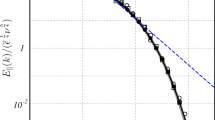Abstract
Flows of engineering interest which have been investigated with the large eddy simulation (LES) technique are discussed. Using this technique the filtered Navier-Stokes equations are solved to simulate the three-dimensional unsteady motion. Not only the statistically-averaged fields, but in addition, the spatial and temporal variations in the flow fields can be examined. Grids are equidistant in the three coordinate directions and typically consist of 150,000 to 200,000 mesh cells. Examples of flows include the turbulent boundary layer with a sudden change in the freestream pressure gradient and the separating and reattaching flow behind a rearward-facing step. Results which illustrate the large-scale structure of these two high Reynolds number turbulent flows are discussed in the present paper.
Similar content being viewed by others
References
Friedrich, R. and Arnal, M.P.: Analyzing turbulent backward-facing step flows with the lowpass-filtered Navier-Stokes equations.J. of Wind Eng. and Ind. Aero., 36, Nos. 1–2, Murakami, S. (Ed.), Special Issue on Comp. Fluid Dyanamics: (1990).
Friedrich, R. and Unger, F.: Large eddy simulation of boundary layers with a step change in pressure gradient. In: M. Lésieur and O. Métais (eds),Turbulence and Coherent Structures, Dordrecht: Kluwer Academic Publishers (1990).
Unger, F. and Friedrich, R.: Coherent structures in favorable and adverse pressure gradient boundary layers. To appear in:Proceedings of the 3rd European Turbulence Conference, Stockholm, July 3–7 (1990).
Schumann, U.: Subgrid scale model for finite difference simulations of turbulent flows in plane channels and annuli.J. Comp. Phys., 18, (1975) pp. 376–404.
Piomelli, U., Ferziger, J. and Moin, P.: New approximate boundary conditions for large eddy simulations of wall-bounded flows,Phys. Fluids A, 1 (1989) pp. 1061–1068.
Schumann, U. and Sweet, R.E.: A direct method for the solution of Poisson's equation with Neumann boundary conditions on a staggered grid with arbitrary size.J. Comp. Phys., 20 (1976) pp. 171–182.
Buzbee, B.L., Dorr, F.W., George, J.A. and Golub, G.H.:SIAM J. Numer. Anal., 8/4 (1971) pp. 722–736.
Narasimha, R. and Sreenivasan, K. R. (1979). Relaminarization of fluid flows.Adv. Appl. Mech., 19, pp. 221–309.9. Schmitt, L. and Friedrich, R.: Application of the large-eddy simulation technique to turbulent backward-facing step flow,Proc. 6th Symp. on Turbulent Shear Flows, Toulouse, Sept. 7–9, Paul Sabatier University, Toulouse, France, (1987) pp. 19.2.1–19.2.7.
Schmitt, L. and Friedrich, R. (1987). Application of the large-eddy simulation technique to turbulent backward-facing step flow,Proc. 6th Symp. on Turbulent Shear Flows, Toulouse, Sept. 7–9, Paul Sabatier University, Toulouse, France, pp. 19.2.1–19.2.7.
Author information
Authors and Affiliations
Rights and permissions
About this article
Cite this article
Friedrich, R., Arnal, M. & Unger, F. Large eddy simulation of turbulence in engineering applications. Appl. Sci. Res. 48, 437–445 (1991). https://doi.org/10.1007/BF02008208
Received:
Accepted:
Issue Date:
DOI: https://doi.org/10.1007/BF02008208




